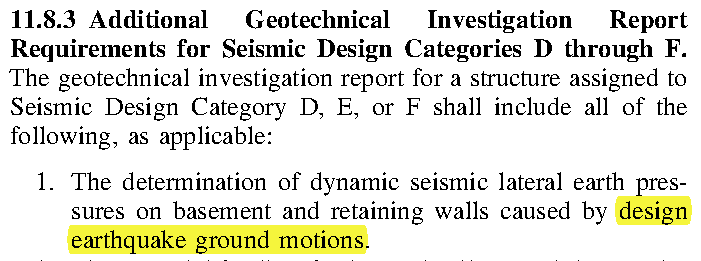The maximum considered earthquake geometric mean (MCEG) peak ground acceleration (PGAM) is commonly used in the USA to perform geotechnical evaluations including liquefaction, lateral spread, and pseudo-static slope stability analyses. However, to determine seismic earth pressures on basement and retaining walls, ASCE 7-10 and 7-16 Section 11.8.3 – item 1 allows using “Design” Earthquake PGA which is 2/3 of maximum considered earthquake. This is because the rest of the structural loads including column and beam loads, shear wall forces, foundation loads, etc are determined using “Design” level earthquake motions NOT “MCE” level, and therefore for a consistent design the loads on basement and retaining walls are recommended to be determined based on “Design” level earthquakes as well.
As you may all know, since ASCE 7-10 the ground motion maps for design of buildings in the USA switched from MCEG geometric mean ground motion maps with 2% probability of exceedance in 50 years to Risk-targeted MCER maps with 1% probability of collapse in 50 years. Having that in mind, let’s take a look at section 11.8.3-item 1 of ASCE 7-10&16:

Per section 11.2 the “design earthquake ground motion” is defined as:

This implies that the 2/3 of MCER level PGA (PGAR) should be used to estimate seismic earth pressures on basement and retaining walls. However, this interpretation completely contradicts the commentary section C11.8.3 that refers to FEMA P-751 (Section 3.2.6) in which 2/3 of MCEG level PGA (2/3 of PGAM) is recommended. It is to be noted that using 2/3 of MCEG level PGAM for earth pressure calculations may make the overall building design inconsistent since the rest of the structural loads are estimated using 2/3 of risk-targeted MCER.
Per the discussion with ASCE 7 Seismic Task Committee (in October 2019), it appeared that Section 11.8.3 – item 1 is meant to recommend using 2/3 of MCEG NOT MCER . The logic behind this recommendation is that the risk factors that are used to develop MCER are not valid for basement and retaining walls. In other words, the fragility curves for building structure, by which the risk factors are developed, are different than those of basement and retaining walls. Since the risk factors for retaining wall are currently unavailable it is recommended to design basement walls for 2/3 of MCEG .
The Seismic Task Committee may make some editorial changes to Section 11.8.3 – item 1 to address the above in the next editions of ASCE 7 Standards.
One thought on “A Design Conflict in Section 11.8.3-item 1 of ASCE 7-10&16 (Determination of Seismic Earth Pressures on Basement and Retaining Walls)”
Awsome !!!